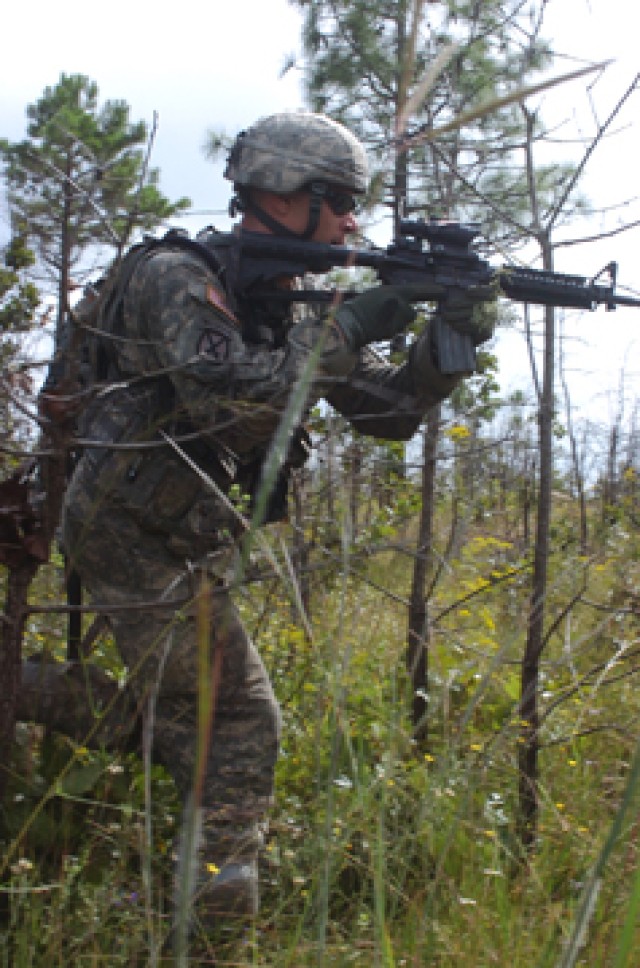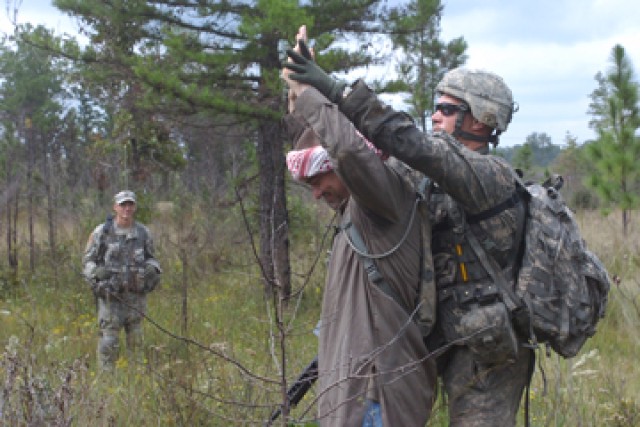FORT POLK, La. -- Gearing up for Afghanistan and building on previous training, 3rd Squadron, 89th Cavalry Regiment, 4th Brigade Combat Team, 10th Mountain Division, conducted a squadron-level field training exercise at Castor 1 and 2 training areas Sept. 21-25.
Lt. Col Phillip Chambers, 3-89 commander, said the FTX was the culminating effort of a three-week training cycle and primarily focused on dismounted battle drills. Cavalry scouts typically move as a mounted element. However, he said 3-89 Cav leaders wanted to ensure their scout platoons trained on the basics of their craft.
"This is our first collective training opportunity, so we have been focused on battle drills because those are the basics of being a combat-arms Soldier," said Chambers. "They're a common denominator behind anything that you do. Everything is built off battle drills.
"The element that you are going to fight with down range is a platoon. By training platoons to be proficient at those tasks, they can execute just about anything else that is asked of them."
Six scout platoons negotiated the reconnaissance lanes, during day and night hours, and they had two weeks of training on their own to practice the battle drills. The FTX was a validation of that training period, said Chambers, who along with Command Sgt. Maj. Ronald Semerena, squadron command sergeant major, assessed each platoon as they negotiated the lanes and conducted after action reviews following each lane.
The platoons had to perform tasks including proper troop leading procedures, pre-combat inspections and checks, reacting to enemy contact such as near and far ambushes, conducting hasty attacks, performing area reconnaissance, handling casualties and reacting to civilians on the battlefield.
"We have a small variable in there so that they can see that there are civilians on the battlefield and situations that force the leader into thinking through a problem quickly and becoming a flexible, adaptable leader," said Chambers. "And that is part of the training objective today, to make sure that we are also getting at the leader training piece."
1st Lt. Jun Shuang Zhang has been platoon leader of 2nd Platoon, Troop A, 3-89 Cav for about one year. After leading his platoon through the day and night lanes, he said his Soldiers have a good foundation of individual tasks, making his job of training collective tasks easier.
"The main goal is to get everyone on the same page as far as platoon SOPs (standard operating procedures) on battle drills," said Zhang. "I think I accomplished most of the goals that I wanted to ... although we do have little things that need to be worked on as far as individual movement techniques."
While many of the battle drills tested are considered infantry platoon maneuvers, Zhang and his reconnaissance platoon performed well, he said. They came a long way in improving from the day mission to the night mission, only having to make minor tweaks. The dismounted techniques they worked on will pay big dividends when they deploy.
"I have never been to Afghanistan, but as far as I know it is mainly a lot of dismounted maneuver, and this training is definitely going to help out in the future," said Zhang. "The bottom line is we worked on a battle drill that is important as we are moving out, because everybody is going to need to know how we react to contact without me giving the command; and I think that we completed that mission."
Running reconnaissance platoon infiltration lanes was a major focus of 3-89 Cav's late-September FTX, however it was truly a squadron-level exercise. Leaders brought to bear every aspect of support the troops maneuvering on the ground needed. From personnel in the tactical operations center to Soldiers providing medical, maintenance, food, fuel, ammunition and transportation support, nearly the entire squadron was involved.
"We looked at this as a great opportunity to exercise an entire squadron ... as a shakeout," said Chambers, explaining that conducting operations this way gets Soldiers in the right mindset to train and gives his organization some momentum.
Sgt. Michael Ledet, platoon sergeant, Headquarters Platoon, Troop D, Forward Support Company, said their distribution, cooks and headquarters sections supported the troops in every way they could. Ledet, who has had three deployments to Iraq and one to Afghanistan, said Troop D Soldiers not only supported other Soldiers but also conducted their own combat-related training.
"Working as a team within the squadron A,AA,A-- not just within ourselves -- that is a big (strength)," said Ellison. "It gives my newer Soldiers an idea of actually what our role is as the S-6 shop, and how we interlink with the other shops and what we provide to the squadron and the troop levels."
Sgt. Maj. Michael Stunkard, 3-89 Cav operations sergeant major, said because of the diverse, mountainous terrain in Afghanistan, a mounted cavalry squadron such as 3-89 Cav will have to dismount their vehicles at some point. Therefore, mounted troops need to be just as proficient with dismounted reconnaissance techniques as they are with their mounted reconnaissance techniques.
"The brigade commander is counting on us to form a good picture of his battle space, and if we can't get out of the trucks and be tactically proficient, we can't give him that picture, especially in Afghanistan."
Chambers believes his Soldiers are well on their way to meeting the challenge awaiting them in Afghanistan.




Social Sharing